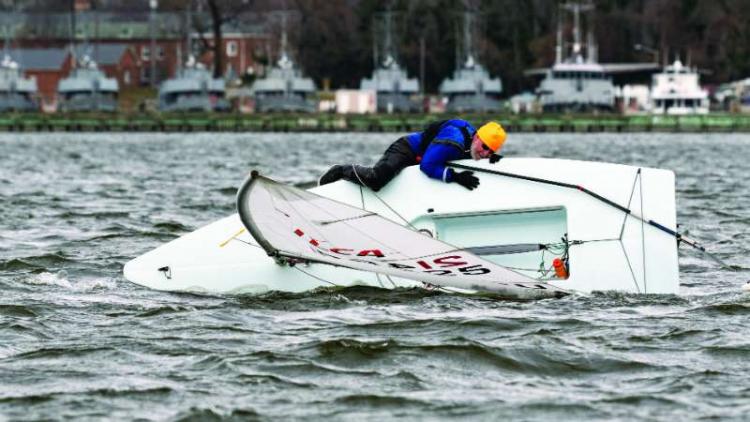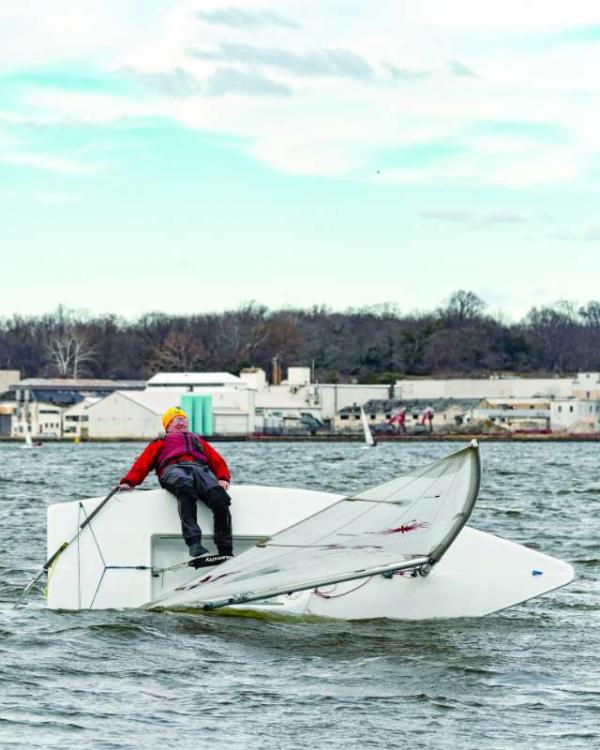You Were Sailing… Then, Smack! Capsized! Now What?
Sometimes, despite your very best intentions, for one reason or another while sailing, you are not in control of your sailboat. Maybe it’s a lack of focus. Maybe it’s an overabundance of fate. But all of a sudden, SMACK!, there you are, capsized.

Because we’re always pushing the limits, trying to go as fast as possible sometimes in sketchy conditions, dinghy sailors—even highly experienced ones—capsize. Sometimes, frequently. It’s just part of the sport. But capsizing can still come as a surprise, so keeping a few key elements in mind is important for a smooth return to Dacron-side up.
First things first: the sailors
Are you all okay? If you’re sailing anything other than a singlehanded boat, make sure your teammate(s) is okay. Often you may end up scattered on different sides of visual hurdles (sails, boat parts), so you may not immediately see your team. Holler out: You okay? If you don’t see or hear your teammates, they are 110 percent priority number one. A related priority: Stay in touch with the boat at all times.
If you have capsized a singlehanded dinghy or have flipped a bigger dinghy and your buddies are okay, do a few quick assessments and actions. Things can be pretty chaotic as you capsize. Disentangle yourself from any lines that could inhibit your ability to maneuver around the flipped boat. Is the boat stable? Or is it likely to keep capsizing, on its way to a “turtled” position? If the boat is still moving, try to move so that you are outside of under the hull when it settles into position. If you do end up under the hull, you’re likely in an air pocket; identify where “out” is, take a breath, and pop yourself back out from under the hull.
Let’s get our boat upright
Okay, now on to getting things sorted and upright. The general principle is that someone gets on the centerboard and uses that leverage to work the boat back upright. In a singlehanded boat, it’s all you. In a double (or more) handed boat, often it’s the skipper who does that, but it can also work to have the largest team member handle that role. Sometimes it may take all crew members, especially if you’re working the boat up from a turtled position. Once the boat is upright, get all your team members back aboard (if you’re crafty, you may be able to “scoop” them as the boat is righting). Take a deep breath and a moment to get everything sorted before you restart your forward progress.
While that all seems fairly straightforward, a few actions can make this process easier. If you have easy access to them, before you try to right your boat, make sure your mainsheet, boom vang, and jib/other sheets are uncleated. Are you in that magic space between the boat and the boom (often where a crew would end up, as opposed to skippers who often somehow magically just step over onto the centerboard in a capsize to leeward)? Make sure the centerboard is down as far as possible. Speaking of centerboards… as tempting as it is to pull or even stand as far out as possible on your centerboard, use caution. The trailing edge of many boards is very thin and can break; focus your effort on the leading edge and/or a bit closer up toward the hull.
Was your capsize one of those fantastic and dramatic “death rolls” where, often when pushing the limits a wee bit too far downwind, you capsize to weather, leaving the boom sticking straight up? Note that may mean your mainsail is still drawing, and your boat may be “sailing” (inefficiently, yes), so staying in touch with your boat is important. If it’s possible to swim the bow of your boat up into the wind, that may make righting your boat easier. If not, as you right the boat, the boat may then capsize again to leeward, but this time in a more traditional fashion that’s a tad bit easier to recover from.
Stay afloat and connected to the boat
Capsizing often happens in challenging conditions. And that can mean that it’s harder to stay connected to your boat or something else that floats. Or that the first few moments you’re in the water, you’re not in control of things at all, or are disoriented. So, wear your lifejacket (as in, it should be on anyway, not just something you look for after you capsize!). Let it do the hard and very important work of keeping you floating.
Capsizing takes everything in your boat and shakes it up and plays it out like rolling dice. Are the critical items connected to the boat? Did you bring your phone with you so that you could snap some shots out on the Bay? Make sure these critical items stay with the boat rather than creating a scatter zone of chaos around your capsized boat. I’m a big fan of smallish dry bags for storing phones, radios, sailing instructions, and such—you can simply clip the fastener around something to ensure it stays with the boat in case of adventure.

Sailboat capsize practice can be fun
When’s the last time you capsized? (For me it was in Miami crewing on a Snipe about a month ago. Dramatic, instantaneous death roll about 100 yards after the weather mark in a huge puff. Back in the boat park after sailing, we received rave reviews: “It was loud, wow!” “Second-most dramatic Snipe capsize I’ve ever seen.” “Are you guys okay?!?” And so on.) I’m not saying go out and practice in 20-plus knots and big waves to see if you can get the boat back up. I’m suggesting a lighter-air day in a protected area where you know the water is deep enough where even if you turtle, your mast won’t hit the bottom. Take other folks with you, in another sailboat or perhaps a coach boat, in case you run into issues.
On a hot summer day, this practice can actually be a heck of a lot of fun. In addition to building critical skills, capsize practice is a big hit at junior sailing programs.
“Capsizing is one of the first things we practice when we start any sailing class,” explains Travis Carlisle, junior program director at Severn Sailing Association. “Practicing how to capsize and what to do if the boat does capsize on top of you is really important for sailors’ confidence. In the summer, once you teach the kids how to properly capsize, it turns into something they actually ask instructors if they can do. It really is important for the kids to learn how to properly recover from a capsize and not to panic when it happens. As long as you are calm and collected, capsizing is not a big deal.” #
About the Author: SpinSheet columnist for more than a dozen years, Kim Couranz has earned several national and world titles in Laser Radials (ILCA 6) and Snipes. She has also raced J/22s, J/24s, and Ynglings on an international level.
Find another favorite Couranz article here.




